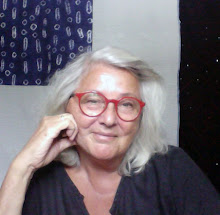 |
| Earth Ark (left ) and Precious Water (right) installed in the Espanola United Church for the Espanola fibre festival |
I’d like to speak tonight about the process of making . I want to state my belief that making something slowly with one’s hands is perhaps one of the most nourishing things one can do. Creating something from nothing – or better, creating something new from something no longer needed or wanted is healing for the planet and for us.
The panels of the Manitoulin Circle project are now finished objects. It seems that every few months they are invited ‘out’ and the women who made them and I are given a chance to re-visit them. We re-consider them. We reflect.
 |
| The Marimekko secret back of Earth Ark in foreground, Layers of Time in background |
I’m a dyer and I'm learning about
local Manitoulin plant dyes. I'm a
stitcher and am attracted to work that is not only large in measurements, but also in length of time. I like it when I can’t see the end of a
project, and when I can’t touch the edges.
My work is about the process of making it.
Two women
thinkers I’d like to remark on tonight.
The first is Sue Bender, author of a book called Plain and Simple, a
woman’s journey to the Amish. She lived
with an Amish family for 6 months, and noted that the women treated everything
they did as if it was a ritual. Whether
breakfast for the family or a stunning jewel toned quilt – everything was given
respect. Art making is connected to
daily life.
The second
woman is a British metal smith who writes and thinks about slow craft as social
change. Her name is Helen Carnac. Helen Carnac calls making
things by hand and experiencing the nourishment that comes from creating for
its own sake rather than for commercial purposes a ‘social
revolution‘. I haven’t used those words before about hand work and am struck by them.
 |
| Marimekko secret back of Precious Water (foreground) and Mended World (background) |
The nice
thing about textile art is that it is possible for others to see the process. It’s not as mystical as some other art media. The process is evident. The hand’s gesture is evident. So go with that. Take
pleasure in what you do.
 |
| Mended World, (left), Trinity (centre) and Layers of Time (right) installed in the Espanola United Church for the fibre festival. Also notice the book of hands open on a table in near left of photo |
My passion has
always been stitch. I've stitched nearly every day since I was
about 8. Stitching is a life-long love affair. As I get older I worry less and less about
making a product that others might like, and more and more about spending what
time I have left to dye and stitch on a large scale. I will be
teaching the techniques of the project in Newfoundland next October, and have started
to prepare for that. It’s really
challenging to fit four years of slow making and a life time of inspiration
into a three day workshop that people will actually pay the craft council of Newfoundland to take. The prep is taking quite a bit of time but perhaps it’s
like writing this speech. Both make me
look at the circle project again. Re-considering how the panels went together
and what the project meant is helping me to think through what and how I want
my life to be like. Artful.
I am
ambitious and have the dream to be recognized for my stitching but it’s way too
easy to let the career advancement become more important than doing the work. Doing the
work is the most important thing. Take great
pleasure in the doing. Slow down,
breathe, stitch, dye, knit or felt, whatever it is that you do, do it with
respect. Honour the experience. This is
my motherly advice tonight.
The above text is just part of Judith e Martin's keynote address to the Espanola Fibre Festival. If you want to read the entire lecture, email Judy and make a request.
One of the nicest things that happened that evening was that several of the participants spoke spontaneously about their experience stitching with Judy.
One of the nicest things that happened that evening was that several of the participants spoke spontaneously about their experience stitching with Judy.















No comments:
Post a Comment